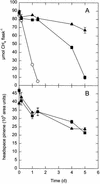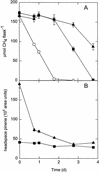Effect of selected monoterpenes on methane oxidation, denitrification, and aerobic metabolism by bacteria in pure culture
- PMID: 9464387
- PMCID: PMC106076
- DOI: 10.1128/AEM.64.2.520-525.1998
Effect of selected monoterpenes on methane oxidation, denitrification, and aerobic metabolism by bacteria in pure culture
Erratum in
- Appl Environ Microbiol 1998 Sep;64(9):3546
Abstract
Selected monoterpenes inhibited methane oxidation by methanotrophs (Methylosinus trichosporium OB3b, Methylobacter luteus), denitrification by environmental isolates, and aerobic metabolism by several heterotrophic pure cultures. Inhibition occurred to various extents and was transient. Complete inhibition of methane oxidation by Methylosinus trichosporium OB3b with 1.1 mM (-)-alpha-pinene lasted for more than 2 days with a culture of optical density of 0.05 before activity resumed. Inhibition was greater under conditions under which particulate methane monooxygenase was expressed. No apparent consumption or conversion of monoterpenes by methanotrophs was detected by gas chromatography, and the reason that transient inhibition occurs is not clear. Aerobic metabolism by several heterotrophs was much less sensitive than methanotrophy was; Escherichia coli (optical density, 0.01), for example, was not affected by up to 7.3 mM (-)-alpha-pinene. The degree of inhibition was monoterpene and species dependent. Denitrification by isolates from a polluted sediment was not inhibited by 3.7 mM (-)-alpha-pinene, gamma-terpinene, or beta-myrcene, whereas 50 to 100% inhibition was observed for isolates from a temperate swamp soil. The inhibitory effect of monoterpenes on methane oxidation was greatest with unsaturated, cyclic hydrocarbon forms [e.g., (-)-alpha-pinene, (S)-(-)-limonene, (R)-(+)-limonene, and gamma-terpinene]. Lower levels of inhibition occurred with oxide and alcohol derivatives [(R)-(+)-limonene oxide, alpha-pinene oxide, linalool, alpha-terpineol] and a noncyclic hydrocarbon (beta-myrcene). Isomers of pinene inhibited activity to different extents. Given their natural sources, monoterpenes may be significant factors affecting bacterial activities in nature.
Figures






References
-
- Amaral J A, Archambault C, Richards S R, Knowles R. Denitrification associated with Groups I and II methanotrophs in a gradient enrichment system. FEMS Microbiol Ecol. 1995;18:289–298.
-
- Amaral, J. A., and R. Knowles. Unpublished data.
-
- Amaral, J. A., and R. Knowles. Inhibition of methane consumption in forest soils and pure cultures of methanotrophs by aqueous forest soil extracts. Soil Biol. Biochem., in press.
Publication types
MeSH terms
Substances
LinkOut - more resources
Full Text Sources

